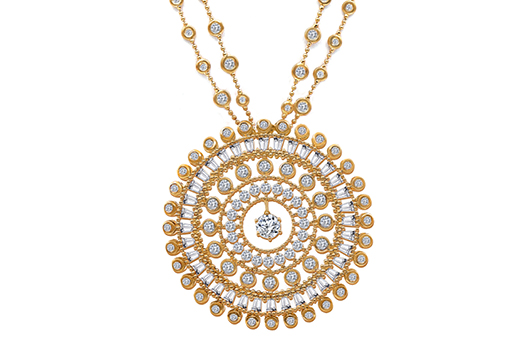
A whole spectrum of colors infused most collections at the Couture show in Las Vegas this year, including an expanding palette of high-quality semiprecious gems. Among these were kunzite, heliodor (green beryl), tanzanite and spinel in several hues. The rosy glow of morganite is also still strong after an upward trajectory that began a couple of years ago and peaked last year. Even known purveyors of top-quality emerald, sapphire and ruby were showing fine examples of more exotic gemstones.
Tom Heyman of Oscar Heyman, who says there is demand for jewelry with striking center stones, displayed pieces with rare cat’s-eye moonstone, indicolite tourmaline and angelskin coral — popular now because of Pantone’s 2019 color of the year, Living Coral.
Colored diamonds were also prominent. Harry Kotlar, for example, announced it was designing a ring for BC Clark Jewelers of Oklahoma City featuring the Heart of Oklahoma, an 18.92-carat, fancy-intense-yellow diamond. The diamond was cut to that size in celebration of BC Clark’s founding date.
Mixing colored gemstones with pearls was popular. Assael stood out with its Colors 2020 collection, which included pairings of kunzite with aubergine-colored Tahitian pearls, keshi pearls with morganite, and blue-tinted Tahitians with aquamarine. Mikimoto, the original master of pearl design, likewise matched high-quality pearls with gems such as heliodor, morganite and aquamarine. The pearls in many of Mikimoto’s pieces are showstoppers in themselves at 16- or 17-millimeter sizes, which are exceedingly rare in the pearl market.
Hyper-linking
In gold- and diamond-focused jewelry, the scope of earring styles has continued to expand, with bypass hoops and French wires emerging as the strongest innovation. The long French-wire look, which eliminates the need for clasps, is practical as well as fashionable. Chandelier earrings are also experiencing a revival, with fringe details and chains surrounding central line elements.
Links are the other big gold story, and the innovation here is shape. From Venetian arches and quatrefoil silhouettes to rectangular, round and square chain-link-fence styles, chains were everywhere. Some pieces had links or sections thereof that could be removed for mixing and matching, or looped together for varied looks. This combination of new link shapes and ultra-convertibility makes for one big megatrend: linkabililty?
Gumuchian, a master of the convertible piece, showed several new examples, including a necklace that could be worn 10 ways. Roberto Coin topped that with a chain-based sautoir that works in 12 different formulations. Pieces by David Yurman included earrings that could serve as climbers, cascades or studs, and new items from the brand’s signature bead collection featured multiple strands for combining or wearing individually. Marco Bicego introduced a necklace measured in bracelet-sized sections, enabling wearers to wrap it around their wrists in multiple strands.
Natural motifs
Nature as a motif is becoming stronger, with vines, leaves and flowers blooming everywhere. Marco Bicego’s new Petali pieces take the form of flowers, with petals inspired by the oblong shapes of its Lunaria collection, and center stamens consisting of substantially-sized diamonds. Mikimoto’s Petals Place Vendôme collection, meanwhile, is a nod to the rose petals that fall in the famous Paris square.
Designer Silvia Furmanovich showed a ring of wood marquetry in the shape of a Japanese maple leaf, inspired by the motifs on traditional obi sashes. She is one of four designers contributing to a capsule collection called 4x4 (four designs by each designer), in conjunction with Canadamark Diamonds and New York jewelry showroom MUSE. Nikos Koulis, another 4x4 collaborator, set diamonds into a cuff bracelet made of bakelite repurposed from an old jukebox. The diamonds in the 4x4 collection are all certified as sourced from either the Ekati or Diavik mines in Canada.
A few other trends stood out as important. Brooches are enjoying a comeback. “Men in particular are wearing brooches and lapel pins on the red carpet,” says Lee Tucker, senior vice president of merchandising for David Yurman. And stacking is still tracking: The latest variation is single items designed to look like they consist of several layered pieces. Finally, jewelry stories are resonating with millennials. One example was the “reflection cards” that came with every piece sold by first-time Couture exhibitor Harakh, an Indian diamond-jewelry maker. Each card carries a message about the piece; for instance, one from an item in the Sunshine collection says the sun “connotes happiness and fills our lives with warmth and brightness” — something that easily applies to all jewelry.
Image: Harakh Jewelry
Article from the Rapaport Magazine - July 2019. To subscribe click here.